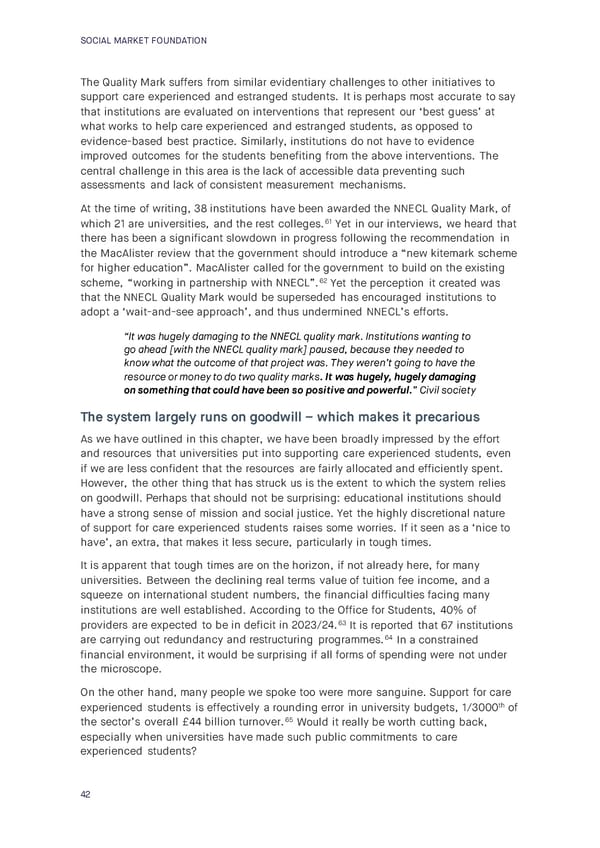SOCIAL MARKET FOUNDATION The Quality Mark suffers from similar evidentiary challenges to other initiatives to support care experienced and estranged students. It is perhaps most accurate to say that institutions are evaluated on interventions that represent our ‘best guess’ at what works to help care experienced and estranged students, as opposed to evidence-based best practice. Similarly, institutions do not have to evidence improved outcomes for the students benefiting from the above interventions. The central challenge in this area is the lack of accessible data preventing such assessments and lack of consistent measurement mechanisms. At the time of writing, 38 institutions have been awarded the NNECL Quality Mark, of which 21 are universities, and the rest colleges.61 Yet in our interviews, we heard that there has been a significant slowdown in progress following the recommendation in the MacAlister review that the government should introduce a “new kitemark scheme for higher education”. MacAlister called for the government to build on the existing scheme, “working in partnership with NNECL”.62 Yet the perception it created was that the NNECL Quality Mark would be superseded has encouraged institutions to adopt a ‘wait-and-see approach’, and thus undermined NNECL’s efforts. “It was hugely damaging to the NNECL quality mark. Institutions wanting to go ahead [with the NNECL quality mark] paused, because they needed to know what the outcome of that project was. They weren’t going to have the resource or money to do two quality marks. It was hugely, hugely damaging on something that could have been so positive and powerful.” Civil society The system largely runs on goodwill – which makes it precarious As we have outlined in this chapter, we have been broadly impressed by the effort and resources that universities put into supporting care experienced students, even if we are less confident that the resources are fairly allocated and efficiently spent. However, the other thing that has struck us is the extent to which the system relies on goodwill. Perhaps that should not be surprising: educational institutions should have a strong sense of mission and social justice. Yet the highly discretional nature of support for care experienced students raises some worries. If it seen as a ‘nice to have’, an extra, that makes it less secure, particularly in tough times. It is apparent that tough times are on the horizon, if not already here, for many universities. Between the declining real terms value of tuition fee income, and a squeeze on international student numbers, the financial difficulties facing many institutions are well established. According to the Office for Students, 40% of providers are expected to be in deficit in 2023/24.63 It is reported that 67 institutions are carrying out redundancy and restructuring programmes.64 In a constrained financial environment, it would be surprising if all forms of spending were not under the microscope. On the other hand, many people we spoke too were more sanguine. Support for care experienced students is effectively a rounding error in university budgets, 1/3000th of the sector’s overall £44 billion turnover.65 Would it really be worth cutting back, especially when universities have made such public commitments to care experienced students? 42
 Care and Learning in Higher Education Page 42 Page 44
Care and Learning in Higher Education Page 42 Page 44